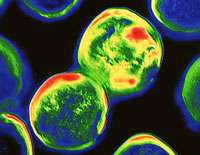Archaeoglobus fulgidus. Credit: Microbewiki
(Phys.org) —A new study in the Netherlands has found a deep-sea microbe living in high-temperature hydro-thermal vents can thrive on chlorate and perchlorate anions. Perchlorate, an ingredient in rocket fuel and fireworks, is toxic to most organisms.
The researchers, led by Martin Liebensteiner of Wageningen University in the Netherlands, have shown for the first time that Archaeoglobus fulgidus, an archaeon living in deep sea vents can survive and grow by reducing chlorate (ClO3-) and perchlorate (ClO4-) anions using enzymes (including some that are molybdenum-based) for the metabolism. Chlorates and perchlorates are not commonly found in the environments in which the archaeon lives.
Hot hydrothermal vents are the result of volcanic activity beneath the ocean floor, and tend to be high-pressure environments poor in oxygen. The water around the vents can be almost at boiling point (60 to 95 degrees C). Most inhabitants of such environments are single-celled anaerobic microbes called Archaea, and one of the commonest of these is A. fulgidus, which resembles a bacterium. It can also be found in land-based hot springs.
A few species of bacteria have previously been shown to reduce chlorates and perchlorates, but the metabolism in the bacteria produces the toxic chlorite, which is then broken down into chloride and oxygen. In the archaeon, chlorite is not split because the microbe lacks the required enzyme, but instead chlorite appears to be eliminated through a chain of reactions involving sulfur compounds. The chlorite reacts with sulfides to produce more highly oxidized molecules such as sulfates. A. fulgidus does not produce oxygen, which is toxic to it.
The researches performed growth experiments on A. fulgidis, along with genomic and proteomic analyses. Liebensteiner was interested in how the microbe would deal with perchlorate because it exists in the environment naturally and anthropogenically, and has also been found on Mars (although the Martian environment is too cold for microbes such as A. fulgidis).
The scientists think that the first organisms to evolve may have been archaeons similar to A. fulgidus and survived by reducing chlorates, perchlorates and other molecules. The conditions on the Earth over 2.5 billion years ago were believed to be similar to the conditions the archaeon thrives in now, and the presence of such organisms may have prevented the accumulation of perchlorates in Earth's early environment long before photosynthetic organisms evolved.
The paper was published in the journal Science on April 5th.
More information: Archaeal (Per)Chlorate Reduction at High Temperature: An Interplay of Biotic and Abiotic Reactions, Science 5 April 2013: Vol. 340 no. 6128 pp. 85-87 DOI: 10.1126/science.1233957
ABSTRACT
Perchlorate and chlorate anions [(per)chlorate] exist in the environment from natural and anthropogenic sources, where they can serve as electron acceptors for bacteria. We performed growth experiments combined with genomic and proteomic analyses of the hyperthermophile Archaeoglobus fulgidus that show (per)chlorate reduction also extends into the archaeal domain of life. The (per)chlorate reduction pathway in A. fulgidus relies on molybdo-enzymes that have similarity with bacterial enzymes; however, chlorite is not enzymatically split into chloride and oxygen. Evidence suggests that it is eliminated by an interplay of abiotic and biotic redox reactions involving sulfur compounds. Biological (per)chlorate reduction by ancient archaea at high temperature may have prevented accumulation of perchlorate in early terrestrial environments and consequently given rise to oxidizing conditions on Earth before the rise of oxygenic photosynthesis.
Journal information: Science
© 2013 Phys.org






















